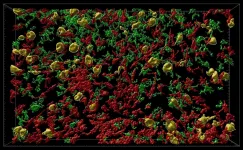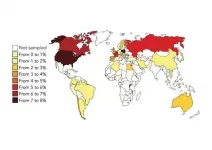(Press-News.org) Scientists are learning that a lesser-studied region on the pandemic coronavirus is recognized by COVID-19 infection-fighting antibodies. These antibodies were identified in blood samples from previously infected patients, and were found to potently prevent the virus from infecting cells.
The coronavirus spike protein is the key that unlocks the door to the cell, and antibodies bind to the spike protein to jam this function. Much attention has been given to studying antibodies that target the receptor-binding domain on the coronavirus spike protein. (The receptor-binding domain of the spike is responsible for triggering the merging of the virus with a host cell to achieve a takeover.)
However, some of the recovered patients' antibodies blocked the coronavirus by binding to a different place on the virus spike -- the N-terminal domain. These antibodies were as strong as those that bind to receptor-binding domain, a recent study shows.
Using electron cryo-microscopy (cryoEM) to map where these antibodies bound showed that all the antibodies that prevent infection bind a single place on the N-terminal domain. The research published in Cell demonstrated that these antibodies protected Syrian hamsters from SARS-CoV-2, the coronavirus that causes COVID-19 in people.
Additional recent findings indicate that the virus is slowly defying these antibodies that people are acquiring. The virus is adapting to these antibodies by accumulating mutations that help the virus escape these defenses, becoming so-called variants-of-concern.
Some of these variants, such as those first detected in the United Kingdom and South Africa, contain mutations that appear to make the virus less vulnerable to the neutralizing power of the N-terminal domain antibodies.
"Several SARS-CoV-2 variants harbor mutations within their N-terminal domain supersite," the researchers noted. "This suggests ongoing selective pressure."
They added that investigating these neutralization escape mechanisms is revealing some unconventional ways the N-terminal domain on the virus is acquiring antibody resistance, and are why N-terminal domain variants warrant closer monitoring.
The senior authors on the Cell paper are David Veesler, associate professor of biochemistry at the University of Washington School of Medicine in Seattle, as well as Matteo Samuele Pizzuto and Davide Corti of Humabs Biomed SA, a subsidiary of Vir Biotechnology. The lead authors are Matthew McCallum of the UW medical school's Department of Biochemistry, and Anna De Marco of Humabs Biomed.
The N-terminal domain antibodies in this study were derived from memory B cells, which are white blood cells that can persistently recognize a previously encountered pathogen and re-launch an immune response.
N-terminal domain-specific antibodies likely act in concert with other antibodies to wage a multi-pronged uprising against the coronavirus. The N-terminal domain antibodies appear to inhibit virus-cell fusion. In conjunction, another part of the antibody, called a constant fragment, might also activate some of the body's other approaches to eliminating the virus.
"This study shows that NTD-directed antibodies play an important role in the immune response to SARS-CoV-2 and they appear to contribute a key selective pressure for viral evolution and the emergence of variants," said Veesler
Continuing research on the N-terminal domain neutralizing antibodies may lead to improved therapeutic and preventive anti-viral drugs for COVID-19, as well as inform the design of new vaccines or the evaluation of current ones.
For example, patients who have recovered from COVID-19 and later received a first dose of an mRNA vaccine might experience a boost in their N-terminal domain neutralizing antibodies. Also, a cocktail of antibodies that target different critical domains on the coronavirus might also be a promising approach for medical scientists to examine to see if it provides broad protection against variant strains.
The researchers stressed that, although current vaccines "are being deployed at an unprecedented pace, the timeline for large-scale manufacturing and distribution to a large enough population for community immunity still remains uncertain."
Antiviral drugs, they explain, are expected to play a role in controlling disease during the ongoing pandemic. They are likely to be particularly helpful, according to the researchers, for unvaccinated individuals and for those who didn't get a strong enough immune response from their vaccinations.
Antivirals could also prove vital when immunity from previous infection or from vaccination wanes, or as mutant strains that break through the shield of vaccination emerge.
INFORMATION:
Scientists at Beamline 5.0.1 at the Advanced Light Source at Lawrence Berkeley National Laboratory assisted in this research.
Anemia, a condition characterized by the lack of healthy red blood cells in the body, is common in patients with chronic kidney disease who need to undergo routine hemodialysis (a process that helps to "clean" the blood when the kidneys don't function well). Thus, red blood cell-stimulating agents (called "erythropoiesis-stimulating agents" or ESAs) and iron supplements (ISs) are administered as part of this process. But, complications can arise if the patients have an altered iron metabolism or poor response to medications. Moreover, the medications tend to be expensive and impose a heavy financial burden on public health. Thus, with such patients currently ...
Malting, the processing of cereal grains into malt, generates rootlets as a side-stream product, which is currently mostly utilised as animal feed. However, this leftover material has not only a high protein content, but also high amounts of phytochemicals, which makes it a highly potential source of development for the food industry, according to a recent study from the University of Eastern Finland, published in npj Science of Food.
Germination increased the amount of phytochemicals
The study utilised metabolomics to analyse samples from grains of four cereals typically used in malting: barley, rye, wheat, and oats. The researchers were particularly interested in phytochemicals, which are bioactive compounds ...
Leesburg, VA, March 18, 2021--According to ARRS' American Journal of Roentgenology (AJR), contrast-enhanced mammography (CEM) showed concordance with MRI in women with newly diagnosed breast cancer and breast augmentation.
Noting that CEM has not been investigated in women with breast augmentation, Molly Carnahan and her Mayo Clinic team in Phoenix, AZ, concluded, "the findings suggest a possible role of CEM for staging in women with breast augmentation and contraindication or limited access to MRI."
From an institutional database of 2,215 women who underwent ...
The immense diversity in the living world and how it came into being has always been a subject of human enquiry. After centuries of playing detective in search of the basis of the parities and disparities that we see among living beings around us, the past century stood witness to some marvellous discoveries in biology and today the Central Dogma of life has been disclosed to us: DNA makes RNA and RNA makes protein (a facile view of a much more complex sequence of events). Together with contributing environmental factors, proteome(s) (total protein content of a cell) collectively influence 'traits' or characteristics of organisms that vary among individuals of a population. In a population, individuals with traits better suited to their environment have a higher chance at survival ...
BIRMINGHAM, Ala. - The triggers and causes of a severe scarring disease of the lungs -- idiopathic pulmonary fibrosis, or IPF -- remain unclear.
Now research published in Science Translational Medicine shows how cadmium and carbon black can trigger lung macrophages to produce a modified protein, citrullinated vimentin, or cit vim, which leads to lung fibrosis. Researchers from the University of Alabama at Birmingham and three other American universities also describe a sequence of mechanistic steps in lung macrophages and lung fibroblasts that leads to the lung scarring.
One of the enzymes involved in these steps -- peptidylarginine deiminase 2, or PAD2 -- may be a promising target to attenuate cadmium/carbon black-induced ...
March 18, 2021 -- A study conducted at Columbia University Mailman School of Public Health reports a high global prevalence of both depression and anxiety during the COVID-19 pandemic and shows how implementation of mitigation strategies including public transportation and school closures, and stay-at-home orders impacted such disorders. The results are published in Psychological Medicine.
"Our research found an elevated global prevalence of these mental health issues during COVID-19 and also revealed there was a wide variance in each at the region- and country-level," said, João Castaldelli-Maia, MD, PhD, NIDA-INVEST Postdoctoral Fellow in the Department of Epidemiology, and ...
Our knowledge of Alzheimer's disease has grown rapidly in the past few decades but it has proven difficult to translate fundamental discoveries about the disease into new treatments. Now researchers at the California National Primate Research Center at the University of California, Davis, have developed a model of the early stages of Alzheimer's disease in rhesus macaques. The macaque model, published March 18 in the journal Alzheimer's & Dementia: The Journal of the Alzheimer's Association could allow better testing of new treatments.
The model was developed by Professor John Morrison's laboratory ...
IN BRIEF:
It's a first: approximately 100 scientists in 42 countries joined forces to learn about the incidence of parental burnout.
They found that Western countries are the most affected by parental burnout.
The cause? The often individualistic culture of Western countries. This international study, published in Affective Science, shows how culture, rather than socio-economic factors, plays a predominant role in parental burnout.
The individualism is more pronounced during health crises.
Does the incidence of parental burnout depend on a country's culture? This question was at the heart of the first international study on the subject for which hundreds of scientists in 42 countries mobilised. In other words, the global scientific ...
The results, published in the renowned scientific journal The Cryosphere, have made it possible to reliably describe snow trends at up to 2000 metres above sea level. Higher than that, there are too few measuring stations to be able to extract reliable information for the entire Alpine region. This consistent data set spans five decades and was created through the collaboration of more than 30 scientists from each of the Alpine states. The results and data collected represent a valuable aid for future studies, especially those which centre on climate change.
"This ...
Bottlenose dolphins learn to cope with coastal construction activities. That is the conclusion of a study published in END ...








